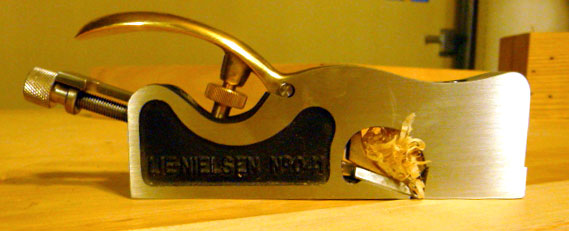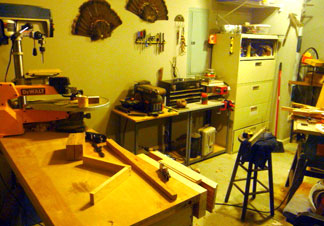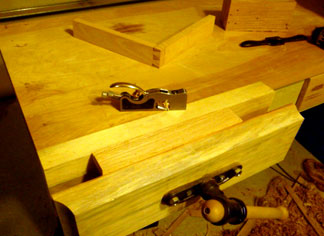 Appreciating the Lie-Nielsen Shoulder Plane
Appreciating the Lie-Nielsen Shoulder Plane
by Christopher Adkins
Atlanta, Georgia
I remember my grandfather using hand tools to build houses and cabinets, as well as small boats for locals
to use to cross the river to their homes in the mountains of western North Carolina, which is where I grew up. The
tools most often were hand made from whatever materials were available and were built for practical use,
not their aesthetics. I was fairly young when my grandfather died and never really had a chance to
learn very much from him. What I learned about woodworking was mostly from my father, who is a successful building
contractor and also an excellent cabinet and furniture maker. Most of the custom homes he built included
custom cabinets that he built himself, and often even a piece or two of furniture that he made. We relied mainly on
industrial style power tools that Dad had picked up here and there and stocked in our 40' by 100'
shop. He taught me to be precise in my measurements and cuts. I learned a great deal from my
father and like to think that I became a skilled craftsman myself because of what he taught me.

I now live in Atlanta and have set up a small shop in my garage. It is not the shop I grew up with,
which included more space than I needed and every amenity, but it is a nice place for me to get away
and relax while doing something I love. With the space constraints and the fact that I still have not
convinced my wife to let me use her side of the garage, I don't have the room for planers and
jointers and every other power tool that I grew up thinking I needed. Instead I have had to look into
other alternatives. This made me start thinking about my grandfather and how he, by-and-large, worked
without the aid of power tools, and instead relied mainly on hand tools. Even those were rather few, but
still enough for him to craft beautiful homes and cabinets.
I have learned that I enjoy the tranquility and the sense of nostalgia I get from using simple, yet
brilliantly designed hand tools. Like many woodworkers, I enjoy the prep time and will often spend
hours in the shop just sharpening my chisels, knives, and plane irons. Growing up in my dad's shop, we
worked hard and it was often cold. There was no heat other than a cigar-style space heater which
was loud, and its fumes burned my eyes. The shop was always dusty and all of the machines were loud and
harsh. I am not saying my shop is better, and I still enjoy spending the day working
with my dad when I visit, but I have found that I get a lot of enjoyment from taking my time cutting dovetails by
hand, or with a table leg clamped in my bench vise, hand planing it to just a slight arch. At times I will
spend hours joining two boards together, simply trying out a new joinery technique I read about.
Not only have I learned to create with much less use of power tools, but my work has become better
as a result. In the past all that was needed to prep work for finishing was to run boards through an
electric thickness planer and then sand them smooth with an orbital sander. Often the result still had the
occasional chatter mark and uneven surfaces with rounded corners from the orbital sander. Now
I now take pride in using my smoothing plane and a hand scraper or spokeshave with
little on no sandpaper to get a smooth, crisp, even surface that takes a finish beautifully.
In this process I have learned to appreciate not only the use of hand tools, but also the inherent beauty of a
well crafted tool. I truly believe that the beauty of the tool can inspire your work. I constantly
search to learn about new techniques and the tools used. I have found most often that simple tools
that have been used for ages are often the best, although quality does matter.
 The most recent addition
to my tool collection is a Lie-Nielsen shoulder plane. I know that I drive my wife crazy when I am
making a new purchase because I obsess for days and even weeks before making a decision. I research
the web for as much information as I can before making up my mind what to buy.
The most recent addition
to my tool collection is a Lie-Nielsen shoulder plane. I know that I drive my wife crazy when I am
making a new purchase because I obsess for days and even weeks before making a decision. I research
the web for as much information as I can before making up my mind what to buy.
Many may argue that a shoulder plane is not a necessity in your arsenal of shop tools and that
there are many other tools that can be used to accomplish the same task as a shoulder plane. While
I agree this may be true, I find myself constantly reaching for my shoulder plane
and truly enjoy using it. I will tell you the first time I placed the plane on a piece of wood
straight out of the box, I was in love.
After much debate, I chose the Lie-Nielsen plane for several
reasons, with the first being the craftsmanship of the tool. The tolerances are so close that at
first glance it is almost impossible to see the line where the body and adjustable mouth plate come
together. The adjustment of the blade is fast and simple. The blade is ready to use straight out
of the box, and with only some minor honing and close adjustment of the mouth plate, I experience almost no
tear out.
Lie-Nielsen makes three sizes of the shoulder plane. I chose the small version.
The small shoulder plane fits comfortably in the hand and works
great for trimming tenons and cleaning out dadoes as advertised. I use my tablesaw to cut the two outside edges
of my dado and then clean out the middle with the shoulder plane. I like the size and weight of the small
shoulder plane, and because of its 5/8" wide blade, I can even use it to clean out dadoes that tightly fit
plywood that is less than a true 3/4".
Not only is the Lie-Nielsen shoulder plane a well crafted and highly functional tool, it is also a
beautiful addition to any tool collection. It's a tool with character that makes me
want
to create. A
well polished and sharpened tool running across a piece of wood, making it smooth and cutting precisely with thin
shavings curling out of the mouth of the plane leaves me with a feeling that I am part of many
generations of learning, and that I am creating something that will be enjoyed for many more
generations.
See the Lie-Nielsen Small Shoulder Plane
Christopher Adkins is a third generation builder and woodworker. He works as a project manager
for a national residential builder, and has also built many custom and log homes, as well as
cabinets and furniture. He also enjoys working with metal and fusing glass.
He can be reached directly via email at
cwadkins2899@msn.com
.